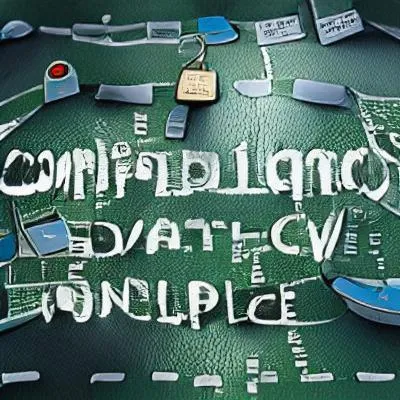An Introduction
In 2023, we expect that regulators will focus on the following:
According to “https://raddllc.com/t”
- The intersection between cyber risk management and technology risk management
- The need for organizations to manage both types of risks as part of a more extensive compliance program
- How third-party vendors impact organizations’ IT infrastructure
As technology continues to evolve…
The World of IT Compliance in 2023’s landscape has become increasingly complex..
Businesses need to navigate a wide range of regulations and standards, such as:
- HIPAA,
- PCI-DSS, SOC 2,
- GDPR
even to build this website, checks have to be passed for GDPR and privacy – otherwise ads cannot be shown (pending!)

A strange illustration of the world of IT compliance: What are the key challenges for IT Security & compliance in 2023?
Key challenges in 2023
The key challenges of IT compliance for businesses are…
1) Keeping up-to-date…
.. with the ever-changing landscape of regulations and standards. Businesses must stay informed about new and updated regulations, and understand how they apply to their operations.
Necessary controls and procedures to meet compliance requirements must be implemented, those include implementing security measures such as encryption and access controls, secure configurations, patch management, security configurations: boundary fdirewalls….as well as regularly monitoring and auditing systems and processes.. IT services in 2023 need to be prepared.
2) Trusting Cloud Services and maintaining security
As businesses increasingly adopt cloud services for their IT operations, it is important to ensure that these services are secure and compliant with industry standards. Here are several key steps businesses can take to build trust in cloud services and maintain security in IT compliance:
- Conduct a thorough risk assessment:
Evaluating the security risks associated with using cloud services is an essential first step in building trust. This includes understanding the types of data that will be stored in the cloud, the sensitivity of this data, and the impact of a data breach. - Choose a reputable provider:
Selecting a reputable cloud service provider with a proven track record of security and privacy is essential for building trust in the cloud. This includes evaluating the provider’s security certifications, such as SOC 2, ISO 27001, and PCI DSS, as well as the provider’s data protection and privacy policies. - Implement encryption:
Encrypting data both in transit and at rest can help prevent unauthorized access and protect sensitive information stored in the cloud. This includes using strong encryption algorithms, such as AES-256, and regularly updating encryption keys. - Establish access controls:
Establishing access controls for cloud services is essential for maintaining security and protecting sensitive data. This includes setting up user authentication and authorization policies, as well as regularly monitoring access logs and conducting regular security audits. - Stay informed:
Staying informed about the latest security trends and best practices is essential for maintaining security and trust in cloud services. This includes regularly reading industry publications, attending security conferences, and engaging in ongoing security training.
Building trust in cloud services and maintaining security in IT compliance requires a multi-layered approach. By conducting a thorough risk assessment, choosing a reputable provider, implementing encryption, establishing access controls, and staying informed, businesses can build trust in the cloud and ensure that their IT operations remain secure and compliant with industry standards.
3) Having a ‘Solid & Robust – Incident Response Plan...
… set in place in case of a data breach or other security incident is critical. This includes having procedures for reporting incidents, conducting investigations, and mitigating the impact of an incident.
Compliance and auditing is a complex and ever-changing field. Businesses must stay informed about new and updated regulations, implement and maintain the necessary controls and procedures, and have a robust incident response plan in place in order to meet compliance requirements and protect sensitive data.
4) Prepare for Global Warming
As the impact of global warming continues to grow, businesses must take steps to prepare for the risks and challenges it presents, especially when it comes to IT compliance. Here are several ways that businesses can prepare for the impact of global warming on their IT operations:
- Again… Conduct a risk assessment:
Evaluating the potential impact of global warming on IT systems and operations is the first step in preparing for its effects. Identifying the areas most vulnerable to the impact of climate change, such as physical infrastructure and data centres, is essential to creating a strategy for mitigating risks. - Implement disaster recovery plans:
Climate change is increasing the frequency and severity of natural disasters, such as hurricanes, floods, and droughts. Having a disaster recovery plan in place that includes measures for protecting IT systems and data is essential for businesses to continue operations in the event of a crisis. - Invest in renewable energy:
Adopting renewable energy sources, such as solar and wind power, can help businesses reduce their carbon footprint and mitigate the impact of global warming on the environment. This can also help improve energy efficiency and reduce the risk of power outages and data loss. - Update IT compliance policies:
IT compliance policies must be updated to reflect the impact of global warming on IT operations. This includes ensuring that data centres and physical infrastructure are designed and located to withstand extreme weather events, and that data is protected and backed up regularly. - Collaborate with stakeholders:
Businesses must collaborate with suppliers, partners, and customers to mitigate the impact of global warming on IT operations. This includes sharing best practices, identifying and addressing common risks, and developing joint strategies for reducing the impact of climate change.
Global warming is presenting significant risks and challenges for businesses, especially when it comes to IT compliance. By conducting risk assessments, implementing disaster recovery plans, investing in renewable energy, updating IT compliance policies, and collaborating with stakeholders, businesses can better prepare for the impact of global warming and reduce the risks to their IT operations.
5 – The ‘Cost of living’ crisis & managing vulnerable people
The cost of living and vulnerable customer management are important considerations in the complex world of IT compliance. In today’s globalized economy, businesses must operate within a complex regulatory framework that seeks to protect consumers and ensure that they receive fair treatment.
In this context, the cost of living is a key factor that can impact a customer’s ability to meet their financial obligations, such as paying bills or repaying loans. Vulnerable customers, such as those with low incomes, disabilities, or health problems, may be particularly susceptible to financial hardship and require additional support.
In response to these challenges, IT compliance regulations may require businesses to implement processes for managing vulnerable customers, such as offering alternative payment options or providing financial counselling services. By doing so, businesses can help ensure that these customers receive the support they need to maintain their financial stability.
IT systems can play a critical role in helping businesses manage the cost of living and support vulnerable customers.
For example, IT systems can be used to automate billing processes, analyse customer data to identify vulnerable customers, and implement financial management programs.
The cost of living and vulnerable customer management are key considerations in the complex world of IT compliance. By implementing effective IT systems and processes, businesses can help ensure that they meet their regulatory obligations and provide the support that their customers need to maintain their financial stability
6 – The War in Ukraine
Effects IT Security / and compliance.
How does a world war effect the complex world of IT compliance, especially Russian threat?
A world war could have a significant impact on the complex world of IT compliance. The escalation of global tensions and geopolitical conflict could result in disruptions to international trade, communication networks, and the flow of information.
In particular, the threat posed by Russian aggression could result in increased cyber attacks and data breaches, potentially compromising sensitive information and intellectual property. As a result, IT compliance requirements and regulations may become stricter, and businesses may need to implement additional security measures to protect their systems and data.
Additionally, a world war could disrupt the supply chains of IT companies, causing delays and reducing the availability of critical technology components. This could negatively impact the ability of businesses to maintain IT compliance and adhere to industry standards.
Furthermore, the aftermath of a world war could result in the creation of new geopolitical borders and trade barriers, leading to changes in data privacy laws and regulations. This could create additional challenges for businesses as they work to maintain compliance with these changing requirements.
In conclusion, a world war could have far-reaching consequences for the complex world of IT compliance. To mitigate these risks, businesses should take proactive measures to ensure the security of their systems and data, as well as stay informed about the latest developments in geopolitical conflicts and their impact on the IT industry.
7 – Corona Virus
The COVID-19 pandemic has had a significant impact on the complex world of IT compliance. The sudden and widespread shift to remote work has increased the importance of data privacy and security, as sensitive information is being handled outside of traditional secure environments.
Additionally, businesses must now comply with new and rapidly changing regulations related to the pandemic, such as data privacy laws for remote work and data retention policies for remote workers. This can put significant strain on IT departments, who must update and maintain systems to ensure that they are in compliance with these new regulations.
In response to these challenges, businesses must implement robust IT compliance strategies that prioritize data privacy and security. This may include implementing strong authentication protocols for remote workers, encrypting sensitive data transmitted over the internet, and regularly reviewing and updating data retention policies.
Furthermore, IT departments must also be prepared to quickly adapt to changing regulations and shifting business needs as the pandemic continues to evolve. This requires a flexible and responsive approach to IT compliance, which can be achieved through regular risk assessments, incident response plans, and ongoing security training for employees.
In conclusion, the COVID-19 pandemic has significantly impacted the complex world of IT compliance, highlighting the need for businesses to prioritize data privacy and security in their IT strategies. By implementing robust IT compliance measures, businesses can help ensure that they remain in compliance with new regulations, maintain the privacy and security of sensitive information, and support their employees during these challenging times.
Join Our Community!
🌟 Get exclusive insights and the latest IT tools and scripts, straight to your inbox.
🔒 We respect your privacy. Unsubscribe at any time.
